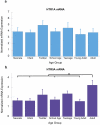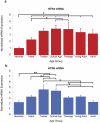Serotonin receptor expression in human prefrontal cortex: balancing excitation and inhibition across postnatal development
- PMID: 21829518
- PMCID: PMC3146513
- DOI: 10.1371/journal.pone.0022799
Serotonin receptor expression in human prefrontal cortex: balancing excitation and inhibition across postnatal development
Abstract
Serotonin and its receptors (HTRs) play critical roles in brain development and in the regulation of cognition, mood, and anxiety. HTRs are highly expressed in human prefrontal cortex and exert control over prefrontal excitability. The serotonin system is a key treatment target for several psychiatric disorders; however, the effectiveness of these drugs varies according to age. Despite strong evidence for developmental changes in prefrontal Htrs of rodents, the developmental regulation of HTR expression in human prefrontal cortex has not been examined. Using postmortem human prefrontal brain tissue from across postnatal life, we investigated the expression of key serotonin receptors with distinct inhibitory (HTR1A, HTR5A) and excitatory (HTR2A, HTR2C, HTR4, HTR6) effects on cortical neurons, including two receptors which appear to be expressed to a greater degree in inhibitory interneurons of cerebral cortex (HTR2C, HTR6). We found distinct developmental patterns of expression for each of these six HTRs, with profound changes in expression occurring early in postnatal development and also into adulthood. However, a collective look at these HTRs in terms of their likely neurophysiological effects and major cellular localization leads to a model that suggests developmental changes in expression of these individual HTRs may not perturb an overall balance between inhibitory and excitatory effects. Examining and understanding the healthy balance is critical to appreciate how abnormal expression of an individual HTR may create a window of vulnerability for the emergence of psychiatric illness.
Conflict of interest statement
Figures




References
-
- Bland ST, Hargrave D, Pepin JL, Amat J, Watkins LR, et al. Stressor controllability modulates stress-induced dopamine and serotonin efflux and morphine-induced serotonin efflux in the medial prefrontal cortex. Neuropsychopharmacology. 2003;28:1589–1596. - PubMed
-
- Naughton M, Mulrooney JB, Leonard BE. A review of the role of serotonin receptors in psychiatric disorders. Hum Psychopharmacol. 2000;15:397–415. - PubMed
-
- Duncan C, Webster M, Rothmond DA, Bahn S, Elashoff M, et al. Prefrontal GABA-A receptor α subunit expression in normal postnatal human development and schizophrenia. Journal of psychiatric research. 2009. pp. 1–42. - PubMed
Publication types
MeSH terms
Substances
Grants and funding
LinkOut - more resources
Full Text Sources
Molecular Biology Databases

